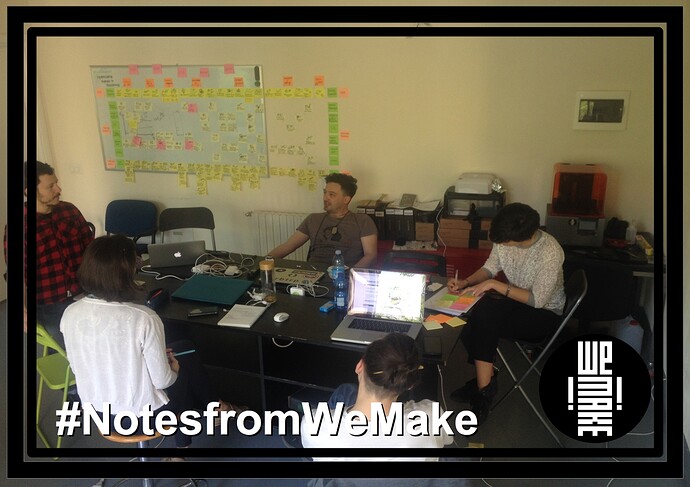In the following months few makers, designers and innovators will be invited as temporary collaborators to the project opencare and will live at WeMake. In the upper floor of the building there are two rooms, two bathrooms, a big open space with the kitchen and a balcony. The idea about Maker in Residence (MIR for short) is that -after a selection- chosen candidates will join WeMake and will get the proper on-site support to develop and accelerate their own project, if it fits to the opencare world.
So, here is a brief ethnography about some talks that emerged during the meetings to organize and plan MIR.
A meeting of the staff - from left to right: Alessandro, Chiara, Costantino, Francesco and Silvia
In the past weeks two of the most recurrent questions by the makers and the staff of WeMake have been: “what is opencare? What does fall under this category?”
This came out during the drafting of the call and after reading the applications. You can read more about the call here: http://wemake.cc/opencare/maker-in-residence-en/
Since the beginning it was clear that either designing an object, like doing “city guerrilla” was certainly not corresponding to taking action about care.
But “if such an object is loaded by local care is opencare”.
Both have an impact on care about the territory, but the second does it with such a goal. It’s not a matter of considering shared and open means, or connecting the health and the social.
“It’s a matter of meaning for us”.
“We found ourselves in many situations where this was absolutely not immediate to be understood”.
About the call.
During the early meetings the staff of WeMake discussed some issues came to discussion. The first one was: “how broad is care?”
Understanding and agreeing on the extension of the concept of care seemed a very important point to put into achieve the MIR project. Although it seems quite a philosophical question, this had a very functional consequence: it made possible to draft the call and also to select the candidates.
A second discussion came on how much physical should have stayed the designed object.
The call itself is based (it has a record) on the physicality (fisicità) of the object, as it was a result of the main experience of WeMake with opencare, given that all services needed new design and that service and hardware may reach a ratio definitely in favour of the services (service 90%; hardware 10%).
“Even if the prototyped object is not material, in a makerspace, a dash of impact for completeness is however needed on the project” It has to do with the way makers think; very creative and very material thoughts are always in the air here. I feel lucky to follow and take notes and records of what is happening and how things are in the making about MIR initiative. I’m looking forward to discussing with the coming makers in residence about it.
